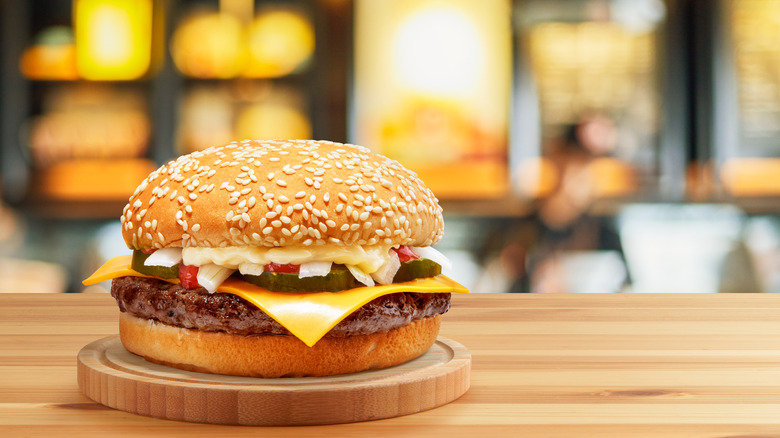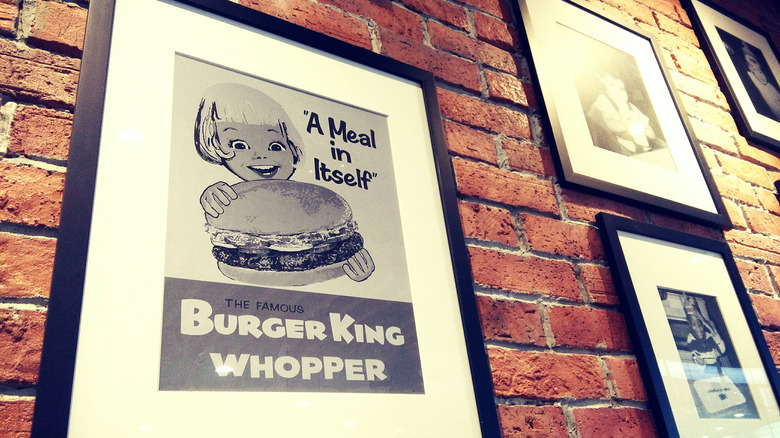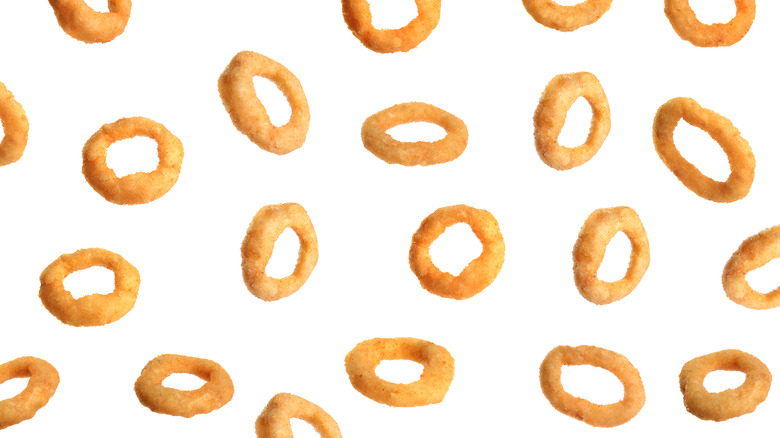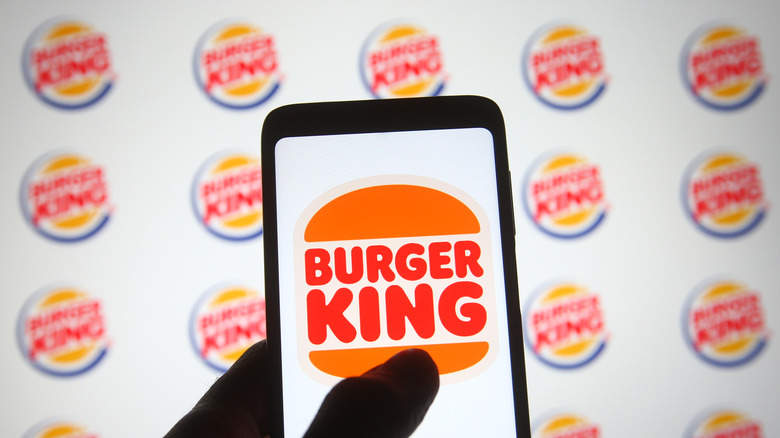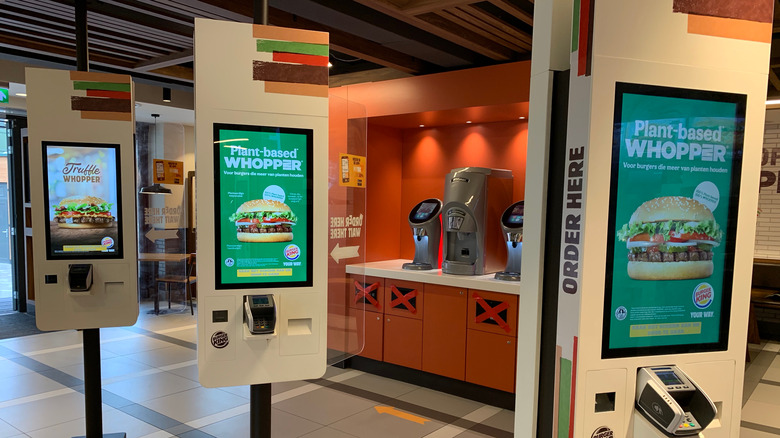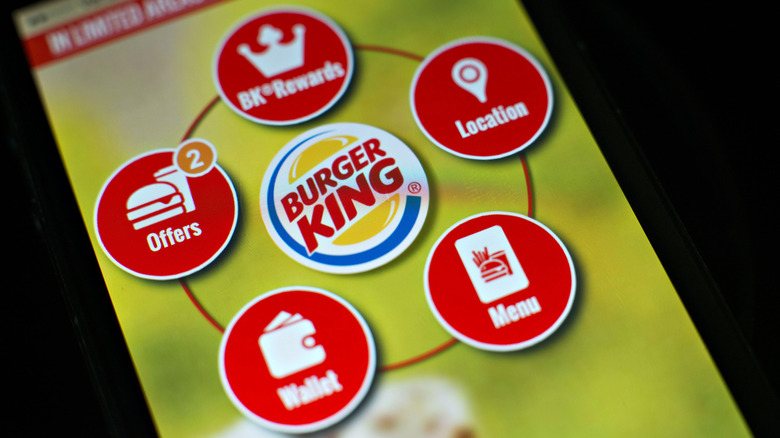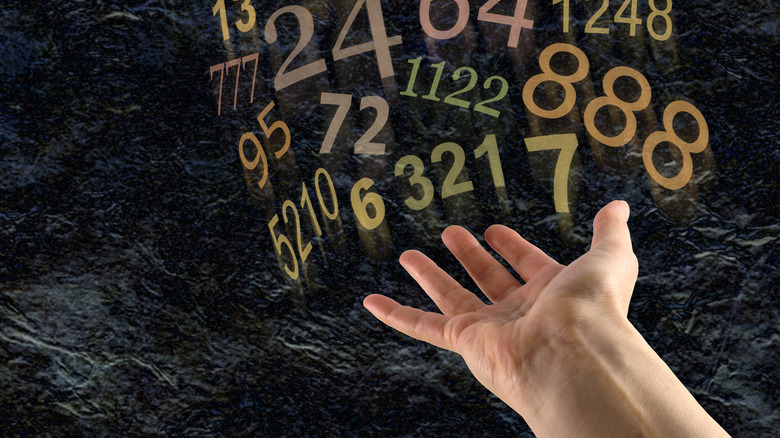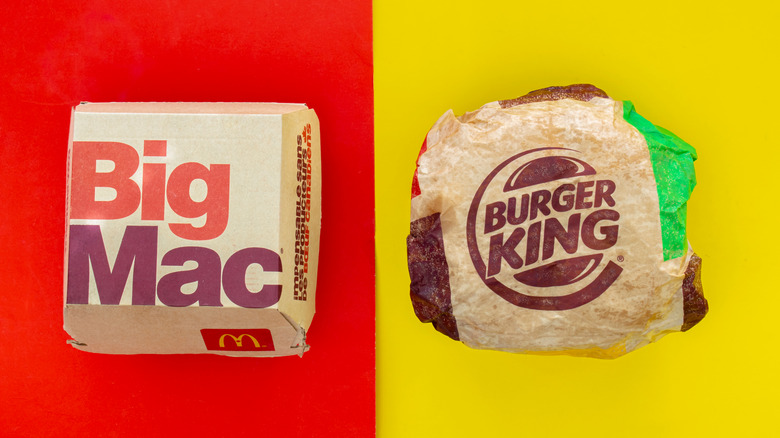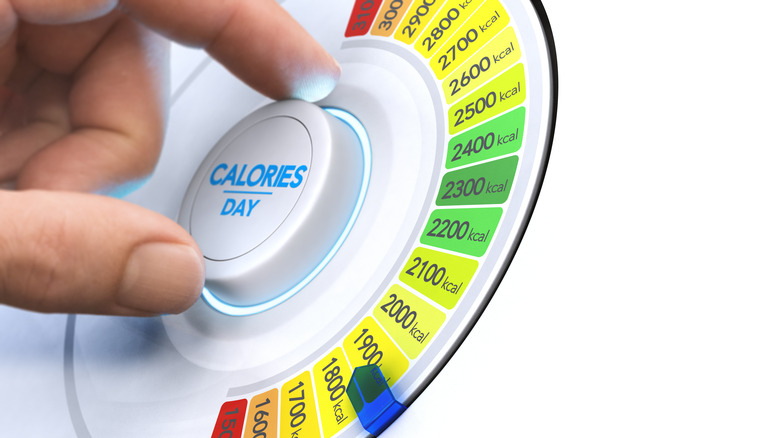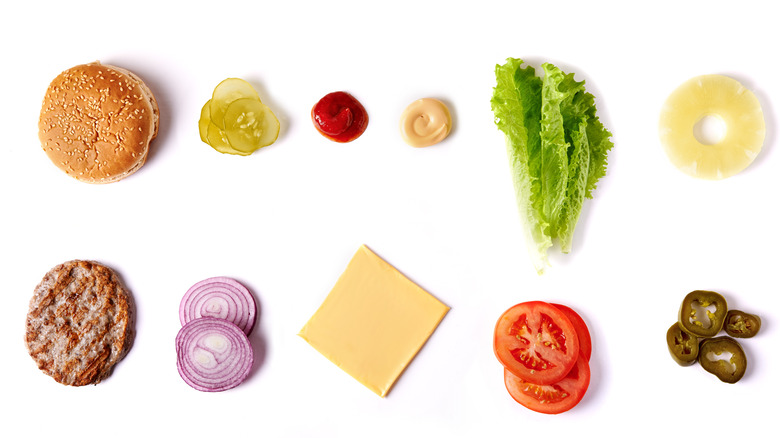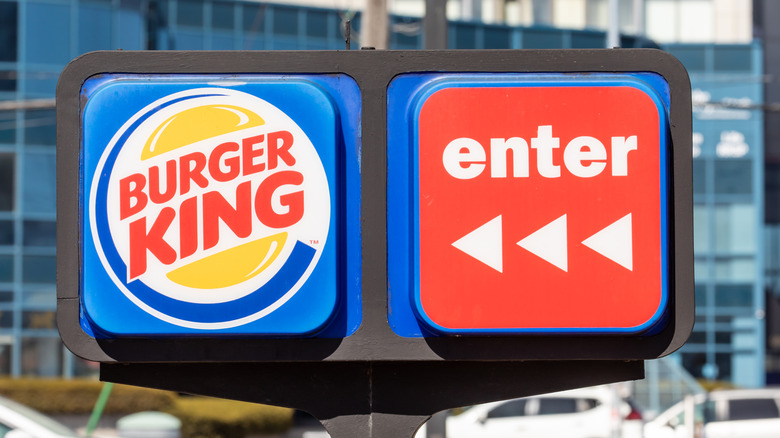Burger King Tricks You Fall For Every Time
Fast food has become a defining feature of American culture. Having constant access to high-calorie indulgences more conveniently than ever has shaped our health and the collective psyche (via American Journal of Lifestyle Medicine). There's no doubt that Burger King plays a formative role in the ever-growing industrial mammoth of questionable sustenance that's snaking its way deeper into our diets.
Between the paper crowns that it regularly bestows upon its fanbase and the sinister monarchical creep that once symbolized its empire, it's clear that Burger King likes to think of itself as fast-food royalty. On some level, the company's shameless branding of self-imposed grandiosity is deserved, considering that Burger King has been in operation for nearly 70 years and has dominated the fast-food market with almost 20,000 locations worldwide. Well-known for its flame-grilled burgers and home of the Whopper, Burger King has fortuitously established itself as an American icon that's branched out around the globe.
Burger King has also proven itself to be a master of marketing — and as with most powerful institutions, it has a slick ability to cleverly utilize those techniques to covertly shape our perception and behavior to its advantage. Fortunately for you, we're here to give you a heads-up on what to be on the lookout for. Here are some Burger King tricks you fall for every single time.
The chain plays to your nostalgia
At the start of 2021, CNN reported that Burger King was revamping its image for the first time in 20 years, tapping into a more retro look with a simplified logo, curvaceous font style, and bold color scheme. The new imagery calls to mind the fun-loving times of decades past, evocative of the groovy and vibrant style that was widely fashionable and popularized during the 1960s and 1970s. In fact, per CNN, Burger King had already used this retro logo from 1969 to the early 1990s. Nostalgia is such an effective gimmick that the fast-food giant keeps cashing in on the same marketing strategy.
According to Psychology Today, numerous studies show that feelings of nostalgia tend to spark overwhelmingly positive emotions. We often lean into the past when the present is filled with hardships, and considering the social isolation and collective trauma from the COVID-19 pandemic, it makes sense for Burger King to turn back time with its design. Catering to society's tendency for nostalgia can have a comforting effect on its customer base — and the warm and fuzzies can make us spend more, according to a 2014 study published in the Journal of Consumer Research.
It dupes you with its onion rings
Onion rings are glorious when they're done right. There's nothing like munching through the crunchy seasoned shell to the tender slice of onion that melts in your mouth, each bite alternating between crispy and succulent, the taste gracefully turning from salty to slightly sweet. Plus, they usually come with a tangy dipping sauce that intensifies all these flavors.
Yet, many fast-food restaurants don't offer onion rings, so when you see them on the Burger King menu, it can cause some excitement as you dream of the crackling mouthwatering halos of deliciousness. When you look at a picture of Burger King's onion rings on the menu, they look well-seasoned and perfectly elliptical. But when they arrive, you bite into bland mush. Why? It turns out that Burger King doesn't put whole onion slices in their onion rings. Per the ingredient list, it appears that a breaded ring is formed around a dehydrated onion paste, resulting in almost zero texture. Yet the picture looks so promising that it keeps calling you back for more, in the hopes that maybe this time, they'll be everything you've been hoping for.
Burger King stimulates your appetite with its color scheme
When Burger King recently overhauled its color scheme, it ditched the blue and focused instead on a red and yellow logo and website design. According to Insider, red stimulates the appetite and yellow creates a sense of comfort. When combined, marketing experts refer to this as the "ketchup and mustard theory." Registered dietitian Kari Hartel confirms: "Red activates your appetite so much that it's often used in restaurant logos, on menus, and on tablecloths and napkins." Hartel goes on to describe that, "The color yellow has also been found to stimulate your appetite because yellow is associated with happiness. Your brain actually secretes more serotonin, a feel-good hormone, when you see yellow."
Burger King's decision to revisit its retro look had double appeal: Not only does it cash in on a sense of yearning for yesteryear, but it also embraces warmer tones that stimulate the appetite and boost serotonin in the brain. So when you look at the warm glow radiating from Burger King's color scheme and you suddenly feel an inexplicable sense of joy and a hankering for a cheeseburger, there's a good chance it has something to do with the spectrum of color your eyeballs are soaking up.
Its kiosks get you to spend more money
If you've noticed more kiosks at fast-food restaurants, you're not alone. Business Insider has referred to this development as the "kiosk craze", signifying "the end of fast food as we know it." In an increasingly digitized world, more people are preferring to order their food through a kiosk rather than interacting with other human beings. Deepthi Prakash, global director of product and marketing at TBWA Worldwide, tells The Wall Street Journal that customers tend to feel less judged for what they're ordering through a kiosk, consequently ordering more food. So if you find yourself surprised by a bigger bill when you're done ordering at a Burger King kiosk, it's probably because you feel a whole lot more comfortable being extra indulgent when you aren't under the watchful eyes of another human being.
As well, Hope Neiman, chief marketing officer at Tillster, tells Forbes, "With kiosks, we are able to be smart about what menu items to showcase, which makes it easier to upsell or cross-sell. When you get smarter about how to showcase your menu, you're not just growing your topline, but also your bottom line and that's where this technology thrives."
The chain lures you in with its loyalty program
There is nothing more valuable than customer loyalty when it comes to business, so most companies try to find ways to keep you coming back. In late 2021, Burger King rolled out a new loyalty program dubbed Royal Perks at most of its locations, giving customers points in the form of "crowns" to redeem on future purchases. For every dollar spent on the Burger King mobile app or website, customers receive 10 crowns in addition to daily perks like free upsizes. Ellie Doty, Burger King's North American chief marketing officer, tells CNBC that during the pandemic, "a lot of digital-enabled behaviors really ramped up very quickly," noting that loyalty programs are a way to provide benefits for mobile users. But there's a little more to it than that.
Whitney Gretz, VP of digital and loyalty at Burger King, explains to QSR that increased digital engagement from customers means that Burger King can obtain their data and use it to target them with more personalized ads. In other words, the more money you spend through Burger King's loyalty program, the more your data will be shared, which makes it easier for the chain to find better ways to entice you into spending even more money at its restaurants.
It repeatedly fools you with the left-digit effect
You've probably noticed that the prices for just about everything being sold often end in 95 or 99 cents. Even though an extra few pennies doesn't really add up to any significant savings, the fact that the leftmost digit is still less than the next dollar amount has an enormous impact on your financial decision-making. This is what's known as "the left-digit effect", a psychological phenomenon that warps our perception of product prices, per Psychology Today.
Because we read from left to right, using a slightly smaller number first in the sequence tricks us into thinking we're getting a good deal, even if the price difference is negligible. How important is an extra cent to you? Is there a single valuable item you can buy in today's world for a penny? Yet, a 2009 study in the Journal of Consumer Research consistently demonstrates that this marketing scheme has enough power to manipulate your spending behavior. When you think you're getting a much better deal than you really are, you're more likely to mindlessly splurge on a bacon cheeseburger.
Burger King constantly mocks McDonald's
Burger King sure knows how to cash in on mocking McDonald's. In an open jab at Ronald McDonald, Burger King offered free Whoppers to anyone dressed up like a creepy clown at select locations on Halloween in 2017 (via Business Insider). Again on Halloween in 2020, Burger King set up voice-activated software in the bathrooms at some locations in Denmark and Sweden, so that when customers said "canceled clown" three times (à la Bloody Mary), the lights would cut out and the image of a terrifying clown would appear in the mirror. Even though McDonald's sacked Ronald due to society's growing disenchantment with clowns, Burger King's eerie campaigns are clearly forms of psychological warfare to keep McDonald's imagery tethered to the creepy jester that it's so desperately trying to break away from.
There are plenty of other examples beyond Burger King's Halloween antics, as examined by Forbes. Mocking McDonald's may create amusing publicity stunts and reward Burger King with extra press coverage, but it effectively distracts consumers from the fact that the food is nearly identical in every way. Both menus mostly consist of ultra-thin beef patties, fried potato sticks drenched in salt, and carbonated sugar water. In fact, some of the main menu items are only 1 or 2 calories away from each other. While you're laughing and giving points to Burger King for a sick burn, you're probably not focused on the fact its food isn't any better for you than McDonald's.
The chain obscures its calorie counts
Finding a highly accurate calorie count that's truly reflective of your meal at Burger King can prove quite difficult. Looking at Burger King's online menu, what is most noticeable are the deliciously vibrant renditions of the food that have obviously been prepared by a team of professional food stylists. Under the pictures in a large bold font, is the name of the menu item. In a slightly smaller font just under the name comes the price tag. Finally, in the smallest size and in a shade of color so pale that it practically blends in with the background, is the calorie count. If your vision is even just slightly less than stellar, it may be totally imperceptible.
This same tactic is also deployed on drive-thru menus. Beyond the visuals, the nutritional value listed tends to be for the entreé only — not the combo. If you decide to order a medium combo with a drink and a side, that number could easily double. To further complicate matters, the calorie counts advertised at some restaurants aren't always accurate. The New York Times reported that researchers have detected alarming disparities at restaurants across the country between the calories advertised and actual test results. And it doesn't help that the FDA allows for a 20% margin variation.
It tricks you with extra toppings
Sometimes you just want a little something extra to enhance your burger. Maybe you're feeling particularly hungry or perhaps you just love the additional flavor that certain toppings provide. Sadly, you won't be getting much as far as flavor goes if you order extra toppings at Burger King.
A former Burger King employee writes on Reddit that workers are only supposed to add one extra item when customers ask them to go heavy on a particular topping. That means if you're in the mood for a Rodeo Burger with extra onion rings, you probably won't notice much of a difference, considering that you'll likely get a single additional onion ring. While it's technically true that adding a single topping qualifies as extra, we think it's safe to assume that most people are probably disappointed when they realize how meager of an upgrade that really amounts to.
Burger King enables an addictive loop in your brain
Burger King is in the business of instant gratification thanks to thousands of locations worldwide and an average drive-thru wait time of 193.31. This means that Burger King is uniquely poised to take your order, prepare your meal, and launch its fat-laden food into your mouth in about the same amount of time as the average phone call.
Brian Solis, a digital anthropologist who studies technology and its impact on society, writes in Forbes that instant gratification actually increases impatience. And what do increasingly impatient people crave? Instant gratification. The process triggers an endless loop that feeds itself, and Burger King is undeniably a part of that system as one of the biggest purveyors of fast food in the world. To make matters worse, because fast food stimulates the reward system in your brain, there's also an insidiously addictive component to this process. Disturbingly, these effects can still manifest themselves even if you aren't eating, according to a study published in Psychological Science in 2010.
When you find yourself feeling extra annoyed as you wait, it's probably because companies like Burger King are happily enabling some of your worst traits. The more money you dish out, the faster the chain can sharpen its ability to serve you. And the more impatient you become, the more likely you are to seek even more instant gratification — probably in the form of a Whopper.
